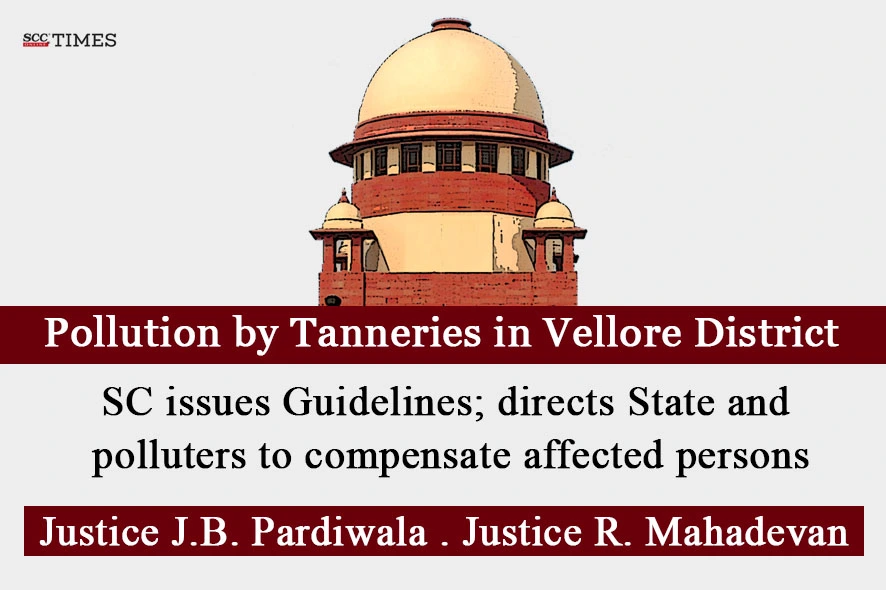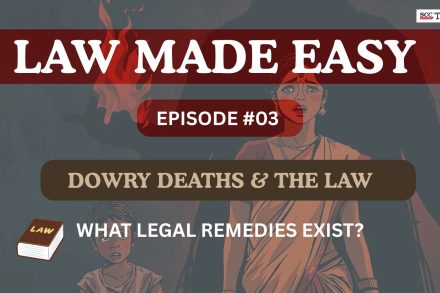Supreme Court: While considering the instant appeals revolving around environmental consequences and the loss of life and health caused by the waste generated by tanneries; the Division Bench of J.B. Pardiwala and R. Mahadevan*, JJ., after a detailed analysis, concluded that tanneries are among the most polluting industries and the damage caused by them by discharging untreated or partially treated effluents into the River Palar and surrounding areas, has resulted in irreversible damage to the water bodies, groundwater, and agricultural lands. This environmental degradation has impoverished local farmers and has caused immense suffering to the local residents and the tannery workers, thereby endangering public health and life.
The Court expressed it anguish stating that despite issuance of multiple directives, no effective steps have been taken by the Governments and Local Authorities; and that Supreme Court directives and environmental norms have been flouted, and the schemes or plans framed by the Government remain on paper and have failed to achieve any meaningful results.
“It is disheartening to hear a worker describe the chemical pollution as “so powerful it can melt the dead – it’s only a matter of time before it begins to melt the living””.
Emphasising that the Court being custodian of fundamental rights, must come to the rescue of the affected individuals/ families and ensure that persistent wrongs are rectified; the Division Bench thus laid down several Guidelines for the stakeholders to comply.
Background:
Vellore District is one of the oldest and largest Districts in Tamil Nadu lying on the banks of River Palar. Palar River is the source of drinking water for 30 towns and 50 villages along its banks. Tanning industries which are the main source of income for the Vellore District, convert animal hides and skins into leather. The tanning process is almost wholly a wet process that consumes high amount of water and uses variety of chemicals. tannery wastewater is highly polluted in terms of suspended solids, nitrogen, sulphate, sulphide, chloride, Biological Oxygen Demand (BOD), Chemical Oxygen Demand (COD), and chromium. The tanning industries have been operating with little or no pollution control for more than a century. It was only after 1980 that the treatment of the tannery wastewater was carried out.
Highlighting the pollution caused by untreated effluents discharged by tanneries and other industries in the State of Tamil Nadu into the River Palar, which is posing a great threat to the ecosystem and resulting in the non-availability of potable water in the area, Vellore Citizens Welfare Forum filed a PIL and 1991. The Supreme Court therein directed the Central Government constitute an authority under S.
In the aftermath of the afore-stated directive, Loss of Ecology (Prevention and Payment of Compensation) Authority (LoEA) was constituted by the Government of India. By Award dated 07-03-2001, the LoEA identified 29,193 affected individuals/families and determined the compensation at Rs 26,82,02,328/- for the period from 12-08-1991 to 31-12-1998 in respect of 15,164.96 hectares across 186 villages in 7 Taluks of Vellore District. Further, it was made clear that the liability of the polluting industries to compensate the affected individuals/families would continue beyond 31-12-1998 until the damage caused to the ecology and environment by pollution is reversed.
Court’s Assessment:
Delving into the litigation history and numerous orders passed in the case, the Court took note of the foundational principles of Public Trust Doctrine, Sustainable Development and Right to Healthy Environment. The Court observed that livelihoods of people in Vellore District, particularly farmers, inland fishermen, and rural communities, have been severely impacted by the tanning industry. Excessive sand mining along riverbanks, especially the River Palar, has caused ecological damage, including lowered groundwater levels, riverbank erosion, and loss of fertile land. Farmers face water scarcity, degraded soil quality, and declining agricultural income, with crop failures becoming common. The toxic contamination of soil and water has also led to increased public health concerns, including respiratory and skin disorders. Tanneries in the district, operational since 1914 are a major contributor to these problems. Effluents discharge into fields, irrigation tanks, and the River Palar exacerbates the problem, with untreated wastewater often exceeding safe Total Dissolved Solids (TDS) levels, reaching up to 15,000 mg/l in some cases. The Court further took note of higher concentrations of BOD, COD, TDS, Chloride and Sulphide in the Palar River stretches since 2015.
Delving into the Polluter Pays principle, the Court pointed out that polluting the industries are liable to not only compensate but also bear the costs for restoring the river. Needless to point out that the remedial action would not stop at restoration, but it is a continuous process, to sustain the river, pollution free and a fresh cause of action would commence again if the industries and the local bodies fail in their duty.
Vis-a-vis extent of liability in regard to Polluter Pays principle, the Court explained that idea of the Polluter Pays Principle, though seemingly progressive, must be carefully examined to ensure it does not result in the emergence of a “right to pollute” for those who are financially capable or willing to pay. Whether the liability ends once compensation is paid, or whether it is a continuing liability that persists until the actual pollution is curbed and its effects reversed?
When there is a violation in compliance with the environmental laws, be it by engaging in activities directly involved in causing pollution or failure to take steps to curb the pollution and restore the environment or violating any terms of licence granted by any State or central authority and acts in a manner detrimental to the environment, the effect of which causes or is likely to cause degradation of the environment, then the deeming fiction of polluting the environment becomes applicable and the polluter is not only liable to payment of compensation but also to restore the environment.
Vis-a-vis the aspect of Compensation, the Court stated that unlike tangible property damage, the harm inflicted upon ecosystems—such as the destruction of flora, fauna, aquatic life, and the disruption to micro-organisms—is not easily measurable in monetary terms. Additionally, the impact on local communities, particularly their livelihoods, is difficult to assess. Therefore, while the liability is clear, the process of determining an equitable compensation amount is fraught with challenges, as it must account for both the tangible and intangible damage inflicted on the environment and the affected communities.
Concerning Government’s responsibility, the Court said that while polluters bear absolute liability to compensate for environmental damage, the Governments (both Union and State) share an equally significant responsibility to prevent environmental degradation and ensure the implementation of effective remedial action.
“The role of the State is not restricted to initial verification but also extends to continuous inspection and to ensure compliance of all laws and orders. It is pertinent to mention that the States could enforce the compliances of all the laws and the orders even during renewal of any licences”.
While the “Polluters Pay Principle” focuses on directly penalizing offenders, its effectiveness is inherently tied to the vigilance and enforcement mechanisms of the Government and regulatory bodies, and thus, in situations where authorities fail to regulate polluters adequately, the resultant environmental degradation underscores a shared responsibility. The ‘Government Pay Principle’ emerges from this context, aiming to hold governments accountable for regulatory and enforcement lapses.
In the present case, the tannery industries owe a duty of care to the environment and are accountable. Extended Producer Responsibility (EPR) can serve as a pivotal strategy to mitigate pollution and ensure sustainable waste management. Tanneries must adopt traceability systems to track waste generation, treatment, and recycling, ensuring accountability. Financial mechanisms such as environmental fees and deposit-refund systems could incentivize compliance, while penalties and license revocation would deter violations.
The Court also highlighted emerging concept of Ecocide which is defined as ‘unlawful or wanton acts committed with knowledge that there is a substantial likelihood of severe and either widespread or long-term damage to the environment.’ Acts such as the pollution of rivers with untreated sewage, illegal sand mining, large-scale deforestation etc. fall under this definition. The environmental damage occurring in Vellore District could even be categorized as Ecocide, underscoring the urgency of addressing and halting such activities.
Guidelines:
Perusing the matter with details, the Court thus concluded that tanneries have caused great deal of harm to River Palar ecosystem endangering not only public health but has also made condition of tannery workers worse. With a majority of workers being women, the situation is even more distressing. It is also abundantly clear that the discharges were neither authorized nor in compliance with the standards set by the Pollution Control Boards. Therefore, the Court laid down certain Guidelines:
-
State Government is directed to pay the compensation amount to all the affected families/individuals, if not already paid, in terms of the awards dated 07-03-2001 and 24-08-2009 passed by the LoEA within six weeks. Furthermore, the State Government was directed to recover the compensation amount from the polluters, if not already recovered, by initiating proceedings under the Revenue Recovery Act or through any other means permissible by law.
-
The State government in consultation with the Central Government, shall within a period of four weeks, constitute a committee, under the chairmanship of a retired High Court Judge and members, comprising of the Secretaries of both the State and Central Departments, environmental experts, representatives from the affected communities, and any other person as it deems fit, for the purpose of conducting an audit to identify, maintain and create a clean and healthy environment in Vellore District.
-
Since pollution is a continuing wrong until the condition is reversed, the polluters shall be liable to compensate the victims and liable for the damage and the Committee constituted as per afore-said directive, LoEA must periodically assess and pass appropriate orders till then.
-
State shall implement the suggestions of the committee to formulate and implement a comprehensive rejuvenation plan for the Palar River, which includes removing pollutants, desilting, and ensuring adequate water flow and direct the concerned authorities and bodies to accomplish the same within a time frame.
-
The State shall ensure quarterly inspections of tanning industries in the district to assess compliance with environmental regulations and publish a report in its website disclosing all the material particulars.
-
State shall facilitate a conduct of environment audit of each river in the State, ascertain the pollution, degradation, change in storage capacity, depletion of groundwater level and publish the results on the website, newspapers, media, and other public platforms.
-
State shall direct that AI systems shall be employed to analyze the data collected from IoT sensors and industry discharge reports, and any discrepancies from prescribed discharge limits shall be flagged for prompt regulatory response.
-
The State/Central Pollution Control Board shall in co-ordination with State government, set emission standards for the tannery industry in alignment with international environmental standards and take into consideration the recommendations of national and international regulatory bodies. Additionally, assess the feasibility of imposing effluent charges, which would be levied per unit of waste or discharge released, as a penal measure to enforce compliance.
-
State shall direct that every industry/tanner is to conduct annual health checkups for workers to detect potential risks of cancer and other severe diseases and ensure that prompt medical assistance should be provided, ensuring that workers are not left to fend for themselves.
-
State government shall ensure the implementation of the ban on illegal sand mining and establish a monitoring committee to oversee sand mining operations, implement stringent action against offenders, including the perpetual seizure of equipment and vehicles involved in illegal mining activities.
-
The Central and State Governments shall take adequate measures and allocate funds to maintain a clean and healthy environment.
CASE DETAILS
|
Citation: Appellants : Respondents : |
Advocates who appeared in this case For Petitioner(s): For Respondent(s): |
CORAM :









